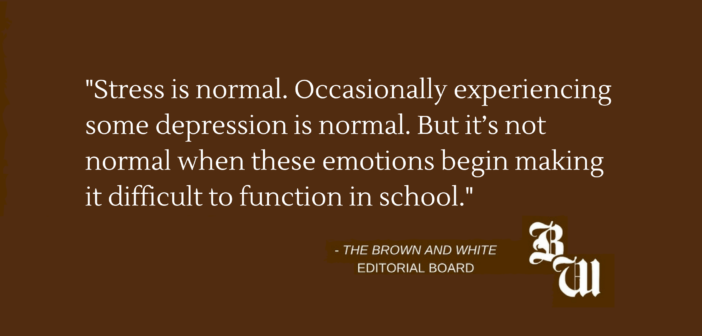Transitioning from bright red leaves to pure white snow is as exciting as it is stressful.
Everything seems to happen at once. Lehigh-Lafayette week concluded our own personal championship, followed by a much-needed Thanksgiving break. We’ll spend the next two weeks frantically preparing papers or presentations and the following two finishing finals.
The days get shorter as work begins to pile up after break. Stress levels on campus are turned up to 11, and frustrations begin to take their toll.
Maybe drama with your friends or roommates is hitting an all-time high. Maybe you’ve been struggling in a class and are worried you won’t do well on the final. Or maybe you feel depressed working on a project where success seems further and further out of reach.
For most people, the end of the semester means an end to the dreary mix of winter and schoolwork. But for others, the dreariness negatively affects their daily lives long past their last final.
If you notice you fit the latter category whenever this time of year comes around, you might have seasonal affective disorder, or SAD — a type of major depressive disorder that occurs alongside a change of seasons.
SAD affects an estimated 10 million Americans. It is genetic in nature, predisposing children whose parents experience SAD. Patients are diagnosed if they experience major depressive symptoms during specific seasons across two consecutive years.
Students most commonly experience SAD during mid-fall through mid-spring. Serotonin, a nerve transmitter found in sunlight, is difficult to come by in these months. Daylight savings, classes, finals and harsh temperatures offer very compelling incentives to stay indoors.
Stress is normal. Occasionally experiencing some depression is normal. But it’s not normal when these emotions make it difficult to function in school.
Mental symptoms of SAD include feelings of hopelessness or sadness, difficulty concentrating, irritability and avoidance of social situations. Physically, people tend to feel a significant drop in energy level, oversleep more and gain weight.
The stress of the college lifestyle can lead to doubt whether negative emotions are more than just the result of a heavy workload. If you shut down when thinking about an unfinished essay, you might worry others will assume you’re lazy. If you tend to push yourself harder than others, you might think you should always be doing more.
The consequences of SAD should not be dismissed. Since the 1950s, the suicide rate among young adults ages 15-24 has tripled. A 2015 study found that roughly 6 percent of undergraduate and 4 percent of graduate students “seriously considered attempting suicide in the past year.”
Of those, nearly half did not tell others what they were feeling.
Four out of five of the most stressful schools are located in the northern United States, facing darker nights and colder winters each year. Students at these schools are at higher risk for SAD and other depressive disorders.
Cornell University, for example, installed “suicide fences” along bridges on campus as a preventative measure on their northern New York campus, later replaced with netting.
We reside on the fringes of this risk zone here at Lehigh. It’s important to recognize when we, or our peers, are behaving irregularly and retracting from social occasions.
As a country, we’ve made significant steps to address mental disorders like depression as problems rather than delusions to “get over.”
This is one of the only times in our lives where access to free therapy is guaranteed. Don’t be afraid to reach out for assistance when you need it. Practice self-care by getting physical activity and getting out every once in a while to be with friends.
There’s no harm in reaching out for help. There’s no shame in experiencing SAD, in the same way there’s no shame in breaking your leg.
And there’s nothing to be embarrassed about when you feel like the only one who’s underwater.
Trust us, you’re not.






Comment policy
Comments posted to The Brown and White website are reviewed by a moderator before being approved. Incendiary speech or harassing language, including comments targeted at individuals, may be deemed unacceptable and not published. Spam and other soliciting will also be declined.
The Brown and White also reserves the right to not publish entirely anonymous comments.
2 Comments
Ah, depression brought on by low grades at Lehigh. This brings back “fond” memories of the week I would desire only rolls to eat, lots of rolls.
More recently during a week long loss of appetite due to the flu, only Cheetos were palatable.
May your depression be short and your test/paper grades rise; make a comeback the same as the 2017 Brown & White football team against Lafayette.
The situation with depression is that it makes you feel as you haven’t any energy. Also getting away from sleep can take a monumental work, so that it could be hard to imagine exercising at all when you’re depressed.
There are many way to cure depression naturally, but the proven one and easy home remedy for depression is the site which is below. I have used them and I was successful in curing my depression permanently depressiontreatmenttoday.win